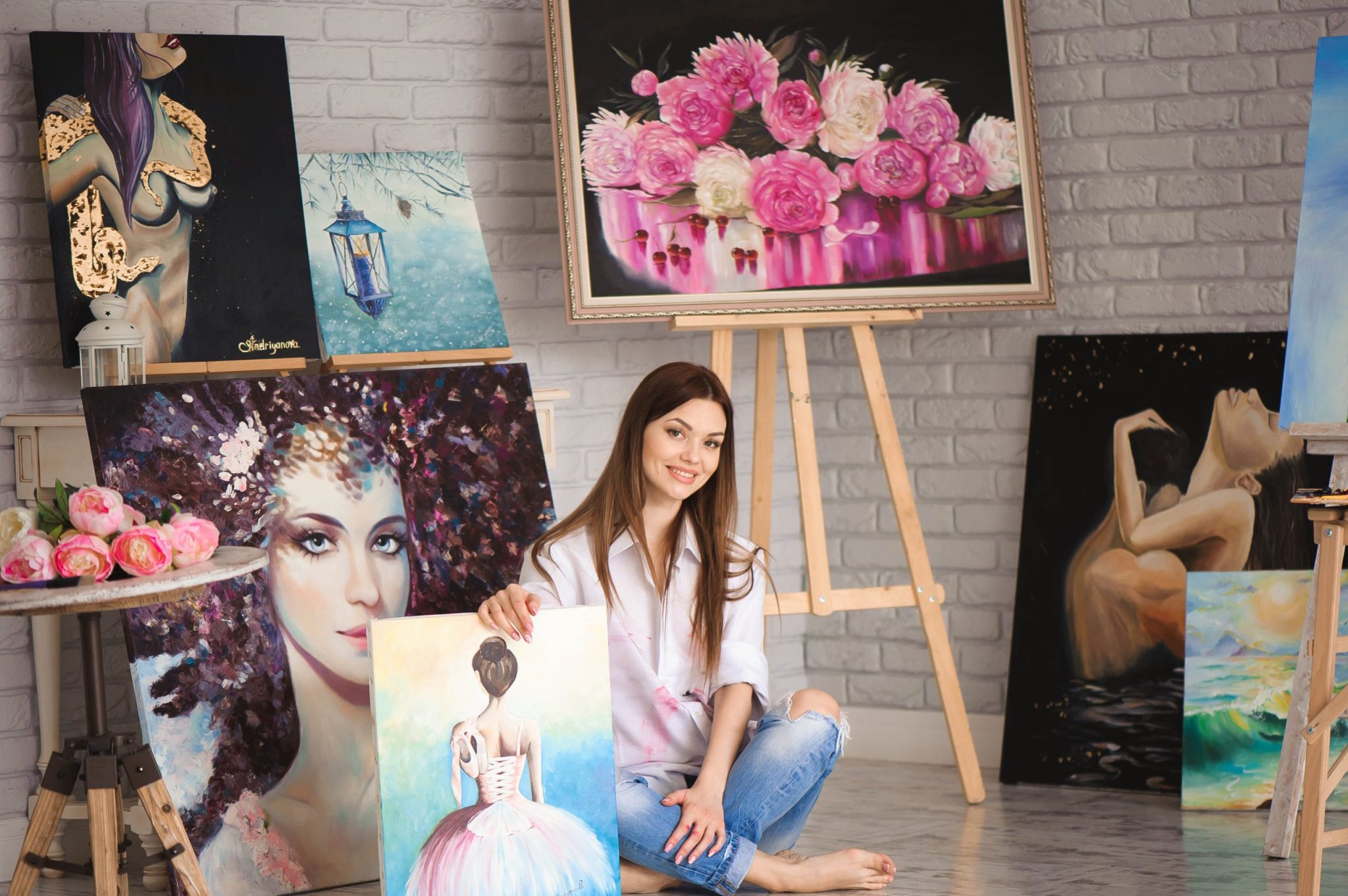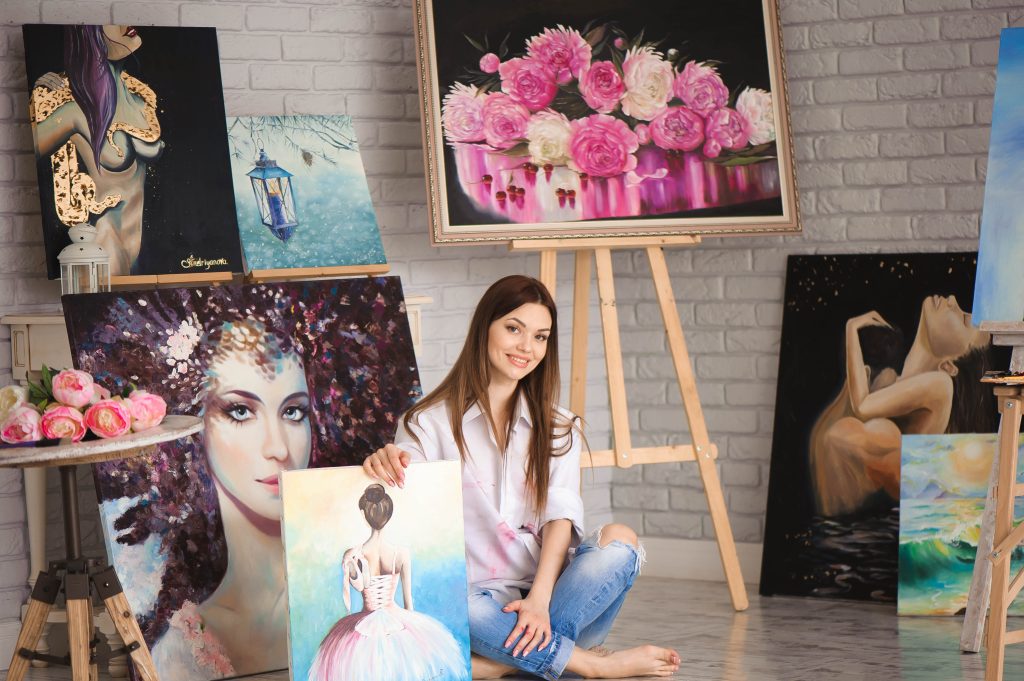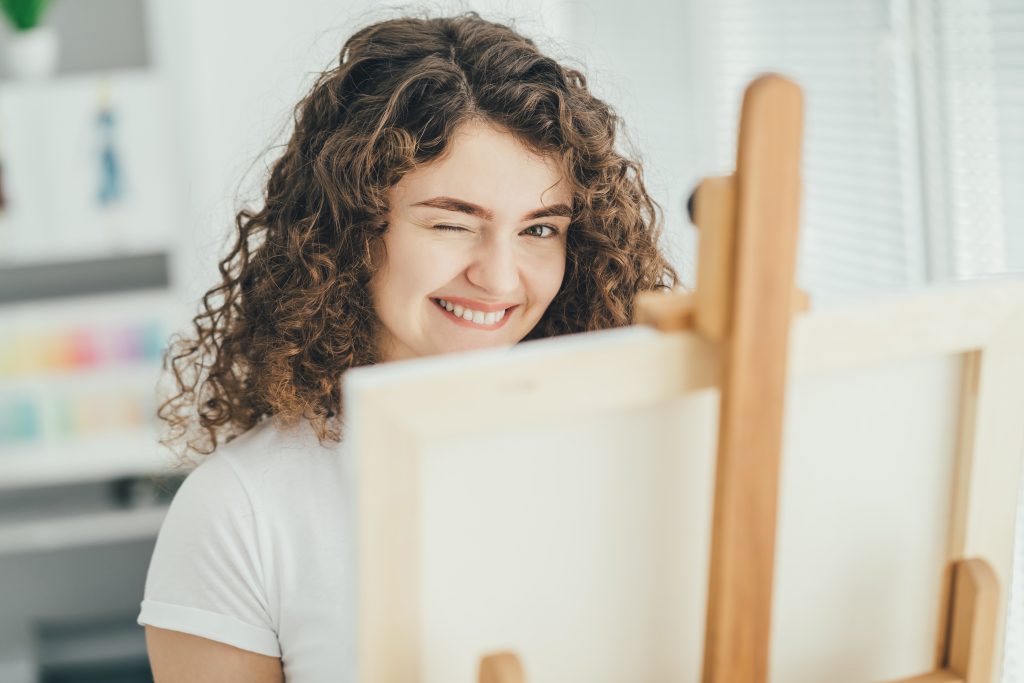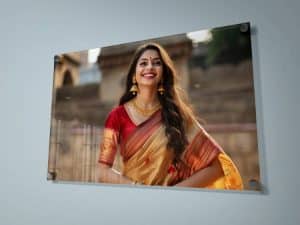
Art school student girl with her painting on exhibition show in a studio
A canvas portrait is a painted or drawn depiction of a person that is often done on a canvas surface. This kind of painting has been popular for ages and may be made using a range of mediums, including oil paints, acrylics, watercolours, and charcoal.
An artist often begins a canvas portrait by sketching the subject’s fundamental characteristics onto the canvas using a pencil or other drawing implement. They may then begin to overlay colours or shading to get a three-dimensional look that correctly depicts the subject’s appearance. The portrait may be hyper-realistic, impressionistic, or abstract, depending on the artist’s style and preferences.

Canvas portraits may be commissioned by people or organisations for a number of purposes, such as a present for a loved one, the celebration of a memorable event or milestone, or creative expression. They may also be used commercially, such as for advertising or hanging in public places.
Overall, a canvas portrait is a timeless and significant work of art that captures a person’s essence and serves as a lasting homage to their memory.
Canvas portraits are a popular way to display family photos, individual portraits, landscapes, and abstract art. These prints are created by printing on high-quality canvas material and stretching it over a wooden frame to create a durable and long-lasting piece of artwork.
One of the most appealing aspects of canvas portraits is their adaptability. They can be hung as a focal point in a room, placed as a decorative accent on a mantle or bookshelf, or even given as a gift to friends or family members.
There are a few important factors to consider when selecting the right image for a canvas portrait. First and foremost, you should choose a high-resolution, high-quality image. This ensures that the finished print is crisp, clear, and vibrant. Furthermore, you should consider the image’s subject matter. A family or individual portrait, as well as a landscape or nature photo, can make excellent canvas prints.
Another important factor to consider is the size of the canvas print. Larger prints make a bold statement and are ideal for filling large wall spaces, whereas smaller prints are perfect for more intimate spaces such as a home office or bedroom.
Printposters.in is a great place to start when looking for a canvas printing company in Bangalore. They provide high-quality canvas prints with 10-colour printing technology, which produces more vibrant and accurate colours than traditional 4-colour printing. This ensures that your canvas portrait will last for many years.
Printposters.in provides a user-friendly online ordering process and quick turnaround times in addition to high-quality printing technology. They also have a team of talented designers who can assist you in selecting the best image and size for your canvas portrait.
Canvas portrait is a timeless and meaningful way to showcase your most treasured memories and artwork. You can create a stunning piece of artwork that will be treasured for years to come by using the right image, size, and printing technology. And you can be confident that you’re getting the highest quality canvas printing in Bangalore when you use Printposters.in.
A canvas portrait needs expertise, patience, and attention to detail. It is usually done by a professional artist that specialises in portraiture, but if you have the requisite abilities and expertise, you may produce a canvas portrait on your own. When thinking about a canvas portrait, consider the topic, the size and format of the canvas, the style of the artwork, and the reason for which it will be utilised.

One of the most typical reasons for purchasing a canvas portrait is to give it to a loved one. A canvas picture is a lovely and meaningful way to mark a particular event or milestone, such as a wedding, anniversary, or graduation. It may also be a meaningful gesture to memorialise a lost loved one. In these circumstances, it is critical to carefully analyse the topic and style of the artwork to ensure that it truly captures and portrays the person’s appearance and personality.
A canvas portrait may also be used for creative expression. Canvas portraits are popular among artists who want to experiment with the human figure and push themselves artistically. The topic and style of the artwork may be less essential in this scenario than the artist’s unique perspective and interpretation. A canvas portrait may also be utilised for business objectives, such as advertising or hanging in public places. The artwork in these examples may have been made to express a particular message or to promote a brand or product.
It is essential to consider the size and format of the canvas while making a canvas portrait. A bigger canvas allows for more detail and creates a more dramatic impression, but a smaller canvas is more intimate and personal. The style of the artwork will also influence the size and format of the canvas. A hyper-realistic portrait may need a larger canvas to reveal all of the details, but an abstract portrait may appear better on a smaller one.
Finally, while producing a canvas portrait, it is important to consider the style of the artwork. Portraits may be hyper-realistic, impressionistic, or abstract, depending on the artist’s vision and the intended audience. The media utilised, such as oil paintings, acrylics, watercolours, or charcoal, will be influenced by the style of the artwork.
A canvas portrait is a lovely and meaningful way to capture a person’s likeness and create a lasting memory. A canvas portrait, whether as a present, a form of creative expression, or for commercial reasons, involves careful consideration of the subject, the size and format of the canvas, the style of the artwork, and the purpose for which it will be used. A canvas portrait may be a timeless and beloved piece of art with ability, patience, and attention to detail.

Sometimes, typical photographs look so common and boring. Converting photographs into oil paintings is a refreshing change, but because so many people have dabbled in these crafts, these portraits can become clichéd. It is also possible that an oil painting of your photograph will not look exactly like your original photograph. I’ve witnessed several portraiture disasters. Have you ever had an oil painting portrait done that didn’t match your image exactly?
Canvas printing on an inject printer is a novel approach to the problems of dull photographs and failed oil (or even watercolour) paintings.
It is the process of transforming a favourite photograph into an elegant and artistic painting. Regardless of how high-tech the snapshot, it will be captured precisely, down to the smallest detail, in a Canvas portrait because a canvas printer like Epson or Canon prints at 4800 resolution.
A photograph is scanned and then transformed into a canvas photograph. A canvas pattern appears on a sheet as a chart of tiny squares or a mesh of stings. Each square represents a canvas stitch. And the stitches are the pictures’ details. It’s incredible to see a photograph transformed into a pattern for the canvas sheet. A snapshot, especially a coloured one, is a faithful replica of a person, a pet, or a significant event. The image, particularly the skin of a person, appears to be of a specific colour in it (dark, fair, brown, yellow, etc.). Even all-black hair could be highlighted with grey, dark grey, and light grey shades.
This is due to light reflections during the photographing process. When the photo was taken outside, it could have been caused by the flash or the sun’s shadow. However, in a snapshot, it makes no difference because the focus is solely on the image. A canvas portrait, on the other hand, takes into account every skin tone and hair colour (whether plain coloured or highlighted). Finally, the portrait is not only a faithful replica but also nearly identical to the original image of the person, pet, or significant memory.
The cotton threads used in cross-stitching give the image an almost-realistic appearance. The background fabric is woven linen, depending on the count, which gives the finished canvas portraits a unique, handmade look.
Snapshots are keepsakes from a very special person or event in a person’s life.
Take a wedding, for example. Many films are used (or, if the digital camera is used, the memory is all occupied). There are times when photographs are ruined because
a) They were splattered with liquid;
b) the children destroyed them;
c) They become browned as a result of being stored in the attic, and so on.
If a canvas portrait is ever spilt with liquid, it can be dry cleaned (or even washed); it cannot be easily torn up; and if it becomes brown, the dry cleaners can ensure that it returns to its original colours (unless the background fabric is black woven linen).
These misfortunes, however, are unlikely to occur because, once completed, a canvas portrait is framed and hung on a wall for all to see and admire.
Canvas is one of the best ways to preserve a person’s most memorable moments in life. It is because cross-stitch can withstand the passage of time. The discovery of remnants from the last 100 years demonstrates this. This could mean that if a portrait is saved on canvas today, it could live for up to 500 years!
Canvas was once a fad reserved for the religious, royals, and elites. This is because canvas prints were a social status symbol. Canvas prints were considered an elegant, classic, and artistic needlecraft that even the most famous figures in history, such as Queen Elizabeth I and Mary Queen of Scots (who did canvas portraits even while imprisoned), It would be magnificent to restore elegance and class to today’s technologically advanced homes and enjoy pleasures that only the religious, royals, and elites enjoyed in the past by displaying canvas prints on walls.
What is a canvas portrait?
A canvas portrait is a piece of art that is painted on canvas. Canvas is a strong, durable material that is made from woven cotton or linen fibres. It is often used for paintings because it can be stretched over a frame and provides a smooth, even surface for the artist to work on.
Why get a canvas portrait?
There are many reasons why you might want to get a canvas portrait. For example, you might want to:
- Commemorate a special event or occasion, such as a wedding, anniversary, or graduation.
- Honour a loved one who has passed away.
- Add a touch of elegance and sophistication to your home or office.
- Create a unique and personal piece of art that you can enjoy for years to come.
How much does a canvas portrait cost?
The cost of a canvas portrait will vary depending on a number of factors, including the size of the painting, the complexity of the design, and the skill level of the artist. However, in general, you can expect to pay anywhere from a few hundred dollars to several thousand dollars for a custom-made canvas portrait.
Where can I get a canvas portrait made?
There are a number of places where you can get a canvas portrait made. You can hire a professional artist to create a custom-made painting for you, or you can purchase a pre-made portrait from an art store or online retailer.
What should I consider when choosing a canvas portrait?
When choosing a canvas portrait, there are a few things you should keep in mind:
- The subject matter of the painting What do you want your portrait to depict?
- The size of the painting How big do you want the painting to be?
- The style of the painting Do you want a realistic portrait or a more abstract painting?
- The colour scheme of the painting What colours do you want the painting to have?
- The frame of the painting Do you want a traditional frame or a more modern frame?
How to care for a canvas portrait
Canvas portraits are a relatively low-maintenance type of art. However, there are a few things you can do to help keep your portrait looking its best:
- Avoid hanging your portrait in direct sunlight. The sun’s rays can fade the colours of the painting over time.
- Dust your portrait regularly with a soft cloth.
- If your portrait gets wet don’t panic it’s waterproof,
- If your portrait becomes dirty, you can have it professionally cleaned.
With proper care, your canvas portrait can last for many years.





